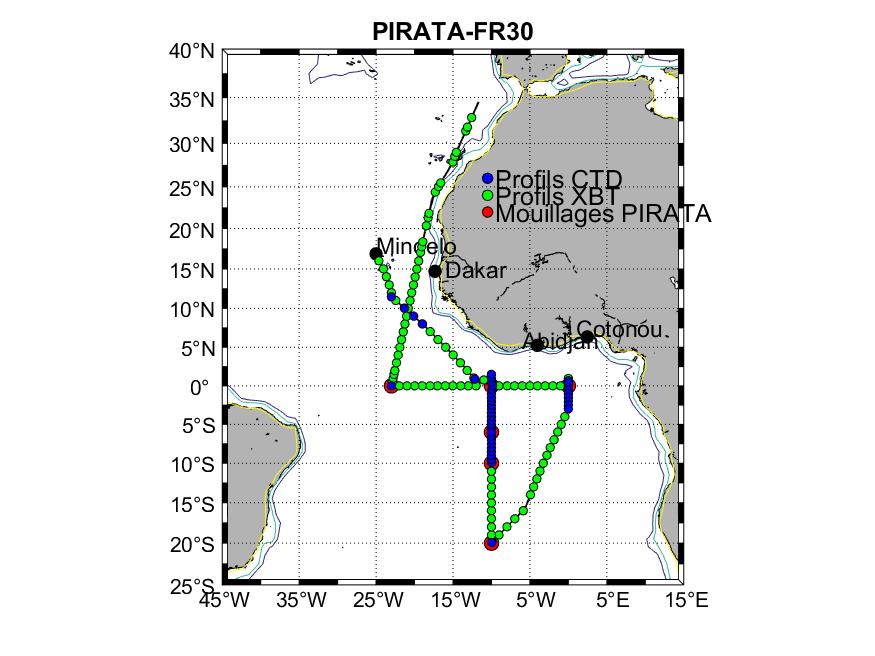PIRATA FR30
| Type | Oceanographic cruise |
|---|---|
| Set | This cruise is part of the set PIRATA |
| Ship | Thalassa |
| Ship owner | Ifremer |
| Dates | 16/02/2020 - 31/03/2020 |
| Chief scientist(s) | BOURLES Bernard , LLIDO Jérôme |
IRD CENTRE DE BRETAGNE IFREMER Centre de Bretagne ZI Pointe du diable CS10070 29280 PLOUZANE +33 (0)2 98.22.45.01 |
|
| DOI | 10.17600/18000690 |
| Objective | PIRATA (« Prediction and Research Moored Array in the Tropical Atlantic ») is a multinational programme (France, Brazil, USA) of operational oceanography initiated in 1997 within the international CLIVAR (Climate Variability and predictability) program framework, and realized in the framework of an international cooperation between USA, Brazil and France (committed countries through a Memorandum of Understanding). It constitutes the main observations network in the tropical Atlantic (CLIVAR, OOPC, GOOS, GCOS) for climate prediction and research, and contributes to OceanSITES. Since 2001, the French component of PIRATA got the ORE label (Observatoire de Recherche de l'Environnement), and is funded by Météo France, IRD, Observatoire Midi-Pyrénées and occasionally by INSU. PIRATA got the SOERE label in February 2010. In January 2011, PIRATA got the label « Service d'Observations Océan-Atmosphère » by CSOA/INSU. At now, PIRATA is part of the CTDO2 (Coriolis-Temps Différé Observations Océaniques) SOERE. In may 2015, PIRATA got also the "South" label from IRD. The SO PIRATA has been positively evaluated by CSOA in 2019 and renewed for the 2020-2024 period. PIRATA is a program for the studies of air-sea interaction in the Tropical Atlantic to seasonal, interannual or longer timescale. PIRATA maintained a network of 10 ATLAS buoys from 1997 to 2005, and has maintained 18 from the summer 2013 (due to successive extensions: 3 buoys off Brazil in 2005, 2 buoys along 23°W and 2 buoys along 20°N by USA in 2006 & 2007, and one buoy off Congo in 2013). Meteo-oceanic buoys allow the description and understanding of the evolution of the upper ocean thermal structure, ocean-atmosphere exchanges of heat and water, spatial and temporal variations of momentum. Observed parameters are used to estimate the exchanges at the air-sea interface along with the oceanic thermohaline structure down to 500m depth. Oceanic (temperature and salinity between the surface and 500m) and atmospheric at the ocean surface (wind direction, wind velocity, air temperature, relative humidity, rainfall, shortwave radiation) data are daily transmitted in real time through ARGOS, and available through internet. In the framework of PIRATA, France is in charge of 6 meteo-oceanic moorings and of three equatorial currentmeter moorings at 23°W-0°N (part of PIRATA international), at 10°W-0°N (installed in the framework of EGEE/AMMA in 2006, now part of PIRATA-France from 2008) and at 0°E-0°N (from 2016, as contribution to PREFACE). From 2015, ATLAS buoys are progressively replaced by T-Flex systems, more performing. The PIRATA FR30 cruise allowed to replace the five meteo-oceanic buoys at 23°W-0°N (T-Flex), 0°E-0°N (ATLAS), 10°W-10°S (T-Flex), 10°W-6°S (T-Flex), 10°W-0°E (ATLAS) and to deploy a meteo-oceanic buoy at 20°S-10°W (T-Flex) as part of a future southward extension of the PIRATA network. The buoy at 6°S-8°E has broken free of its mooring and has gone adrift on August 8th, certainly due to a new act of vandalism again this year. As this happened two times consecutively, the latter was not redeployed during the cruise FR30. The CO2 parameters sensor installed at 10°W-6°S has also been replaced, and a new one has been added at 10°W-0°N (PI : N.Lefevre). The ADCP currentmeter mooring at 10°W-0°N was replaced; the one at 23°W-0°N will be replaced in 2020 by GEOMAR and the 10°W-0°N will be replaced in 2021. Turbulence sensors, at 2 PIRATA sites (5 at 23°W-0°N and at 10°W-0°N), and OTN sensors on the 6 buoys (one on each), were replaced. The PIRATA FR30 cruise allowed to validate the transits by carrying out CTD-O2/LADCP profiles along sections at 10°W (repeated yearly), 0°E for a total of 42 CTDO2-LADCP profiles (1x0-5215m; 4x0- 4000m; 25x0-2000m; 3x0-1000m; 8x0-500m; 1x0-200m) along with 105 XBT profiles along the trackline. 22 surface drifting buoys have been deployed (SVP-B for Meteo-France as contribution to AtlantOS, NOAA/AOML for GCP and SOERE CTDO2) as well as 4 ARGO profilers for CORIOLIS and for the first time in tropical Atlantic, and in concert with the Argo-France deployment cell, the recovery of a Deep-Argo profiler deployed in the area during the PIRATA-FR28 cruise in 2018 was successfully carried out. Numerous sea water samplings (surface and during CTD-O2 casts for a total of 223) have been done for the analysis of dissolved oxygen, salinity, nutrients, carbon parameters (DIC, TA) and primary production (Chl pigments). All along the cruise, additional continuous measurements have also been carried out from the vessel's instruments such as meteorological parameters, ocean currents from VM-ADCP as well as acoustics measurements (along the vertical and the horizontal).
|

